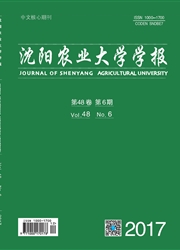

 中文摘要:
中文摘要:
以包括34项质量性状和15项数量性状数据的丁氏收集稻种资源中的2262份为供试材料,采用3种抽样方法、3种类型的性状数据、8种系统聚类方法和调整的欧氏距离构建巢式核心种质,以确定一种最佳的核心种质构建策略。结果表明,抽样比例在2_2%~9.9%之间的核心子集已足以保持原群体最大程度的遗传多样性。整合的质量数量性状构建的核心子集遗传多样性最大,优于仅由数量性状或质量性状构建的核心子集。采用优先取样结合多次聚类随机取样法,结合可变类平均法或类平均法构建的效果最好.由此得到150份核心种质,占原群体的6.6%。对核心种质的评价与验证表明,核心种质绝大部分性状的Shannon-Weaver多样性指数均大于原群体,其表型频率方差均小于原群体,表型保留比例均达到100%,大部分数量性状的均值与原群体无显著差异.最大值、最小值、极差与原群体完全符合。150份核心种质较好地保存了原群体的遗传多样性和遗传结构。
 英文摘要:
英文摘要:
2262 accessions of rice germplasm from Ting's Rice Germplasm Collection with 34 qualitive and 15 quantitative traits were applied to construct a core collection. By using three sampling strategies, three kinds of trait data, eight hierarchical clustering methods, and adjusted Euclidean distance, sixty nested core collection were compared to choose the optimal constructing strategies. The results showed that the sampling rate between 2.2%-9.9% was sufficient to retain the greatest genetic diversity of the initial population. The core collections constructed by integrated qualitative and quantitative trait data retained the greatest genetic diversity and was the best one. Based on the integrated qualitative and quantitative traits and adjusted Euclidean distances, the weighted pair-group average method or the un-weighted pair-group average method was the best strategy for constructing core collection. As a consequence, 150 accessions could serve as a core collection, accounting for 6.6% of the initial population. For the majority of the traits, the core collection had greater genetic diversity index and smaller variance of phenotypic frequency than the initial population. The rate of phenotype retained for the core collection reached 100%. Mean of all quantitative traits for the core collection and that of the initial population had no significant difference. The maxium value, mini- um value and range of the core collection were the same as those of the initial population. 150 accessions of rice core collection well represented the genetic diversity and genetic structure of the initial population.
 同期刊论文项目
同期刊论文项目
 同项目期刊论文
同项目期刊论文
 期刊信息
期刊信息
